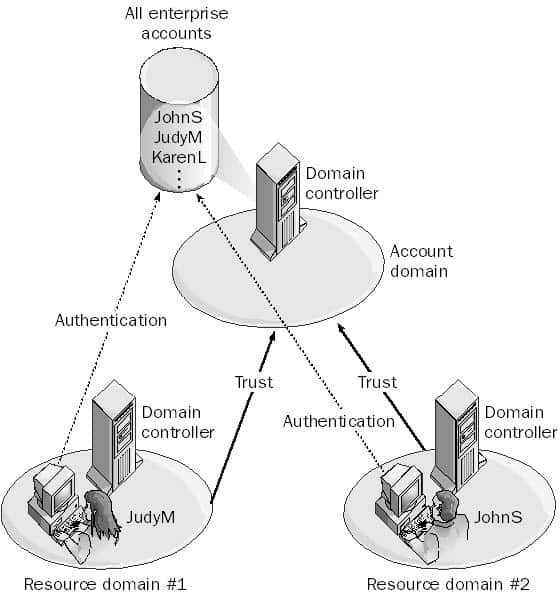In the annals of Windows Server Systems, the progression from Account Domains to the encompassing concept of Active Directory is a testament to the ever-evolving landscape of IT infrastructure management. Let’s journey through the metamorphosis of centralized account management, from its early days as the “Account Domain” to its modern manifestation within the realm of Active Directory.
In this article:
- Account Domain: The Genesis
- Active Directory: The Paradigm Shift
- The Convergence
- Conclusion
- References

Account Domain: The Genesis
Definition and Purpose
An Account Domain, prevalent during the Windows NT era, was a centralized domain that housed global user accounts and group accounts. Its inception was driven by the need for enterprises, especially those with multiple branches, to have a unified location for account administration. Simplifying and centralizing user management was the primary objective.
How it worked
- Centralization: Located typically at corporate headquarters, the Account Domain became the hub for all user accounts across the enterprise.
- Interaction with Resource Domains: Servers and workstations in branch offices belonged to ‘resource domains’. Despite this, users in these branches had to log onto the central Account Domain.
- Trust Relationships: For seamless network logins, trust relationships were established. Each resource domain had to trust the Account Domain, ensuring centralized account access regardless of the user’s physical location.
Active Directory: The Paradigm Shift
The Dawn of a New Era
With Windows 2000 came the introduction of Active Directory (AD) – a more sophisticated directory service. AD wasn’t just a successor to Account Domains; it was a comprehensive overhaul.
Structure and Hierarchy:
- Domains: In AD, domains were more than just central repositories for accounts. They became administrative and replication units, allowing organizations to segment their IT resources effectively.
- Forests and Trees: Active Directory introduced the concept of ‘trees’ and ‘forests’, enabling enterprises to establish a hierarchical, structured view of their IT assets.
Trust Enhanced:
- Active Directory reimagined trust relationships. With features like transitive trusts, AD allowed for complex, multi-level trust configurations between domains.
Account Domains within AD:
- The essence of Account Domains – centralized account management – was incorporated within Active Directory. But instead of a singular Account Domain, organizations could now have multiple domains within a forest, each potentially acting as an “Account Domain” of yore but with more flexibility and administrative autonomy.
The Convergence
It’s essential to note that Active Directory didn’t outright replace Account Domains. Instead, Microsoft integrated the foundational principles of Account Domains into the broader, more versatile framework of AD. Today, when we discuss Active Directory’s domains, we’re invoking the spirit of the original Account Domain but within a context that’s richer, more intricate, and aligned with modern IT needs.
Conclusion
From the singular focus of Account Domains to the expansive vista of Active Directory, Microsoft’s journey reflects the industry’s broader shift towards complexity, flexibility, and scalability. Understanding this transition is key to appreciating the nuances of account and resource management in today’s Windows environments.
References
- Microsoft Learn: Active Directory accounts
- “Active Directory: Designing, Deploying, and Running Active Directory” by Brian Desmond and Joe Richards
- RFC 4511 – Lightweight Directory Access Protocol (LDAP): The Protocol